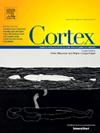通过目标导向对话共享信息的神经基础:一项超扫描功能磁共振成像研究
IF 3.3
2区 心理学
Q1 BEHAVIORAL SCIENCES
引用次数: 0
摘要
人脑维持着物理和社会环境的内部模型,代表着个体的“主体性”。通过对话,两个或两个以上的个体分享他们的模型,并在交流的基础上修改它们,这一过程代表并被称为“主体间性”。为了研究这一动态过程的神经基础,采用超扫描功能磁共振成像技术验证了默认模式网络(DMN)中的脑间同步(IBS)参与主体间性表征的假设。24对说日语的参与者在两天的时间里玩迷宫游戏。每对参与者都得到了一个不同的迷宫,也就是说,一个通往目标的路径不同的迷宫。虽然一对对共享一个迷宫,但每一对中的每个参与者对迷宫布局只有部分了解,他们对布局的了解也各不相同。参与者轮流将棋子移向目标。由于每个人都只有部分信息,因此合作伙伴之间的有效沟通非常重要。行为数据显示,随着游戏的进行,参与者关于潜在的迷宫移动的对话显著增加,这意味着这些信息的交换是至关重要的。相应地,DMN增加了任务相关的激活,包括背内侧前额叶皮层(dmPFC)和双侧颞顶连接(TPJ),通过颞上沟延伸到颞极和右侧额叶中回。在这些区域中,dmPFC和右TPJ在所有游戏中都表现出特定于任务和伙伴的IBS。因此,可能需要DMN来表示主体间性,它基于通过实时对话共享的内部模型。本文章由计算机程序翻译,如有差异,请以英文原文为准。
The neural basis of sharing information through goal-directed conversation: A hyperscanning functional magnetic resonance imaging study
The human brain maintains internal models of physical and social environments, representing an individual’s “subjectivity”. Through conversation, two or more individuals share their models and modify them based on the exchange, a process that represents and is referred to as “intersubjectivity.” To investigate the neural substrates of this dynamic process, hyperscanning functional magnetic resonance imaging was conducted to test the hypothesis that Inter-Brain Synchronization (IBS) in the default mode network (DMN) is involved in representing intersubjectivity. Twenty-four Japanese-speaking participant pairs played maze games over a two-day period. Each participant pair received a different maze, i.e., a maze with a different pathway to its goal. Although pairs shared a maze, each participant in a pair had only partial knowledge of the maze layout and what they knew about the layout differed. Taking turns, participants moved their pieces to their goals. Since each had only partial information about the pathway, effective communication between partners was important. Behavioral data showed participants' conversation about potential maze piece moves significantly increased as the game proceeded, implying that the exchange for such information was critical. Correspondingly, the DMN increased task-related activation, including the dorsomedial prefrontal cortex (dmPFC) and the bilateral temporoparietal junction (TPJ), extending through the superior temporal sulcus to the temporal pole and the right middle frontal gyrus. Within these areas, the dmPFC and the right TPJ showed task- and partner-specific IBS throughout all games. Thus, the DMN is likely required for representing intersubjectivity, based on internal models shared through real-time conversations.
求助全文
通过发布文献求助,成功后即可免费获取论文全文。
去求助
来源期刊

Cortex
医学-行为科学
CiteScore
7.00
自引率
5.60%
发文量
250
审稿时长
74 days
期刊介绍:
CORTEX is an international journal devoted to the study of cognition and of the relationship between the nervous system and mental processes, particularly as these are reflected in the behaviour of patients with acquired brain lesions, normal volunteers, children with typical and atypical development, and in the activation of brain regions and systems as recorded by functional neuroimaging techniques. It was founded in 1964 by Ennio De Renzi.
 求助内容:
求助内容: 应助结果提醒方式:
应助结果提醒方式:


